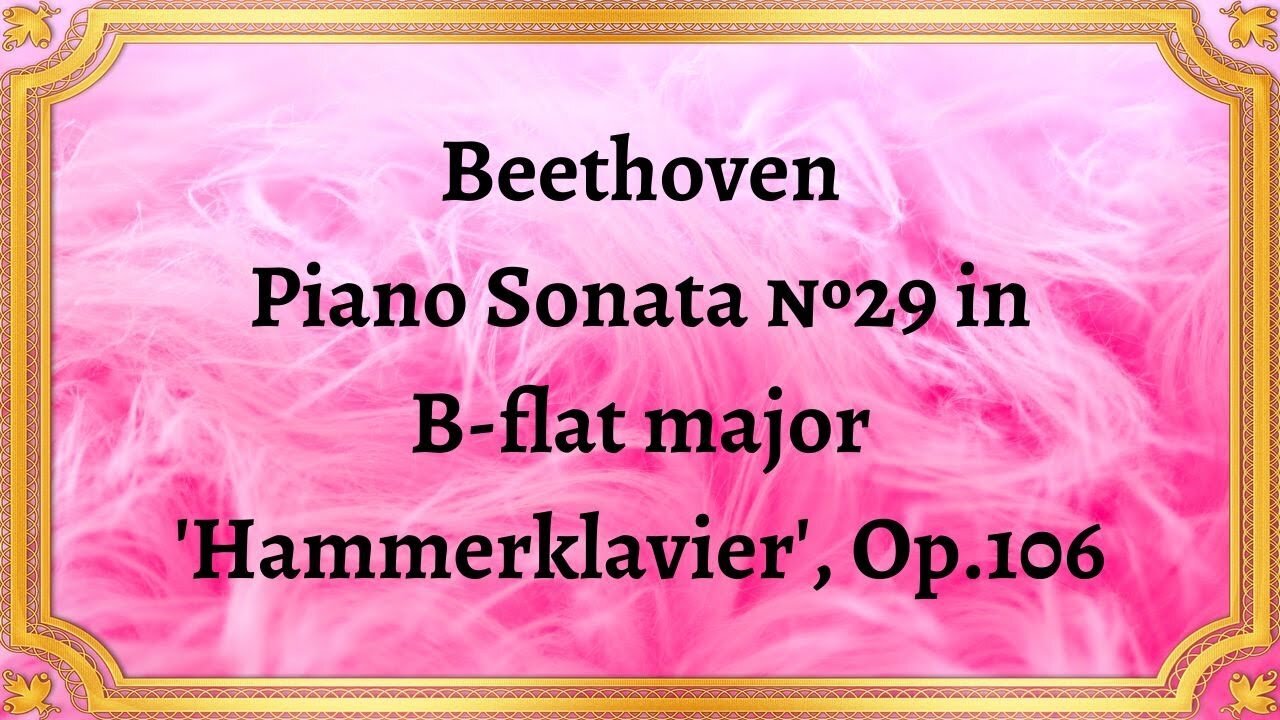Premium Only Content

Beethoven Piano Sonata №29 in B-flat major 'Hammerklavier', Op.106
Beethoven's Piano Sonata No. 29 in B-flat major, Op.106, commonly referred to as the "Hammerklavier," is a monumental work that exemplifies the composer's musical genius and innovation.
Beethoven composed the "Hammerklavier" Sonata between 1817 and 1818, a period marked by personal challenges and creative exploration. This masterpiece emerged during a time when Beethoven's deafness was progressing, leading him to experiment with new musical ideas and push the boundaries of conventional composition. The "Hammerklavier" Sonata stands as a testament to Beethoven's indomitable spirit and unyielding pursuit of artistic excellence.
The "Hammerklavier" Sonata comprises four movements, adhering to the traditional sonata form but expanding it to unprecedented lengths. The first movement is a grand and virtuosic Allegro, followed by a profound and introspective Adagio. The third movement, a monumental Scherzo, provides a contrast of energy and playfulness, while the final movement is a breathtaking fugue that showcases Beethoven's contrapuntal mastery.
The "Hammerklavier" Sonata is renowned for its immense technical demands, pushing the limits of pianistic technique at the time. Beethoven's use of extended range, complex rhythms, rapid passagework, and intricate hand crossings presents formidable challenges to performers, requiring exceptional skill and endurance.
Beethoven's Op.106 Sonata encapsulates a vast emotional range, from moments of transcendent beauty to passages of immense power and intensity. The composer explores contrasting moods, shifting between tender lyricism, dramatic turbulence, and triumphant exaltation. This emotional depth adds to the sonata's lasting impact on listeners.
The "Hammerklavier" Sonata showcases Beethoven's groundbreaking compositional techniques and innovations. From the expanded form and technical demands to the harmonic adventurousness and integration of fugue, Beethoven demonstrates his visionary approach, influencing generations of composers who followed.
Op.106 Sonata represents a turning point in Beethoven's compositional journey. It reflects his tireless exploration of new musical territories, defying conventions and expectations. The sonata's ambition and audacity mark it as a testament to Beethoven's artistic growth and fearless experimentation.
The "Hammerklavier" Sonata stands as one of Beethoven's most significant and revered compositions, captivating audiences and musicians alike. Its grandeur, complexity, and emotional profundity continue to inspire and challenge performers, while its cultural and historical significance make it an enduring symbol of Beethoven's musical legacy.
Beethoven's Piano Sonata No. 29 in B-flat major, Op.106, the "Hammerklavier," is a towering masterpiece that exemplifies the composer's artistic genius and exploration of new musical frontiers. Its vast emotional range, technical challenges, and artistic innovations have solidified its place as one of the most extraordinary works in the piano repertoire. Embark on a musical odyssey with the "Hammerklavier," and immerse yourself in the brilliance and audacity of Beethoven's musical vision.
I. Allegro 00:00
II. Scherzo - Assai vivace 13:14
III. Adagio sostenuto 16:09
IV. Largo. Allegro risoluto 33:25
#classical_music #Beethoven #sonata_for_piano
-
 1:04:22
1:04:22
Timcast
2 hours agoTrump Orders ALL TRANS MILITARY Discharged, Trans Person CAUGHT With BOMBS At Tesla Dealership
44.6K52 -
 LIVE
LIVE
LFA TV
16 hours agoPAYBACK = JUSTICE! | LIVE FROM AMERICA 2.27.25 11AM
4,964 watching -
 DVR
DVR
Bannons War Room
9 days agoWarRoom Live
2.32M410 -
 2:17:39
2:17:39
Matt Kohrs
11 hours agoBREAKING MARKET NEWS: Bounce or Bust?! || The MK Show
33.1K1 -
 47:26
47:26
BonginoReport
4 hours agoEpstein Files Drop Today-But How Much Will They Reveal? (Ep.149) - 02/27/2025
94.8K127 -
 2:59:16
2:59:16
Wendy Bell Radio
7 hours agoThe Left Is Wrong About Everything
71.2K45 -
 29:05
29:05
CatfishedOnline
20 hours ago $3.48 earnedThe Real Jennifer Aniston or Another Romance Scam?
34.8K10 -
 34:44
34:44
LFA TV
5 days agoMIRACLES DO HAPPEN!
65.5K3 -
 16:43
16:43
T-SPLY
5 hours agoCNN Panel Member Forgets Donald Trump Runs The Military
40.1K23 -
 31:13
31:13
World Nomac
1 day agoAMERICAN visits IRAN for 10 days (this is what I found) 🇮🇷
36.6K4